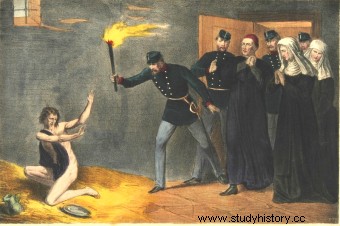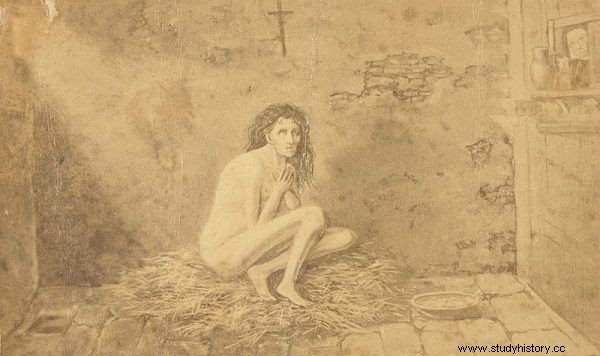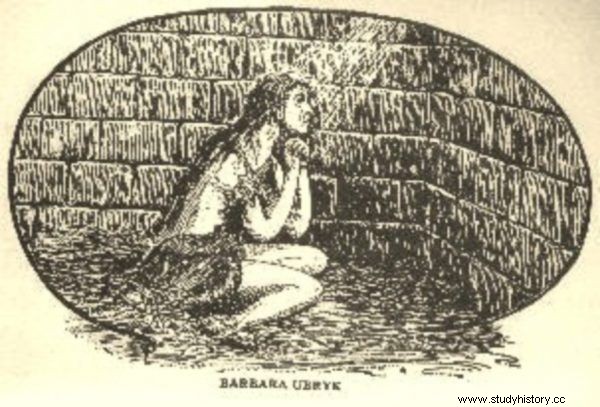An intriguing anonym was submitted to the National Court in Krakow. Its author informed that a sister named Ubryk was imprisoned in the convent of the Discalced Carmelite Sisters. The mention of a nun from a strictly enclosed monastery, where the nuns know only their religious names, proved that the author could have written the truth. The anonymity was therefore not disregarded. It has been placed in an official state.
The civil and church commission established by the District Court in Krakow and Bishop Antoni Gałecki, administrator of the Krakow diocese, crossed the gate of the Discalced Carmelite convent in the suburbs of the city on July 21, 1869. She demanded an immediate visit with her sister Barbara Ubryk. Countess Maria Wężyk, the prioress, initially refused to comply with this request. The authority of the Krakow bishop prevailed. The members of the commission - assistant professor doctor Władysław Gebhardt, a representative of the Krakow bishop, prelate Roman Spithal, assessors Stanisław Gralewski and Teofil Pravi, accompanied by the court recordist Kwiatkowski - were led to the door of the cell. About what they found after opening them, he reported to the public in "Czas" (No. 166 of 24 July 1869):
Upon opening the double doors, [the committee] was stunned at the sight which it introduced. In a cell walled up behind the window, so dark that it was only possible to distinguish day from night, and with stinks overflowing, it turned out to be a creature resembling a human by the flame of a candle, completely naked, sitting on the floor in a corner, covered with dirt and feces. In the cell, apart from dirt and a little rotten straw, which was to serve as a bed for the poor creature, nothing else was found, just two clay bowls with staple and potato fodder. A mephitic [foul, suffocating] stench spread from the outhouse communicating with the cloaca, and with nothing covered. There is no stove or chimney in the cell. When she saw the members of the commission entering her cell, Barbara Ubryk cried out, groaning:Give me some food, roast a little, or I'm hungry!

Lithograph showing the discovery of Barbara Ubryk in the Monastery of the Discalced Carmelite Sisters in Krakow and her liberation on July 21, 1869.
When asked why she was sitting here, she replied:I have committed the sin of uncleanness, but you sisters too ... are not angels ... Bishop Gałecki, who, having come to the monastery and seeing the state of affairs, rebuked the nuns with these words:
- This is your love of your neighbor, women ?! Are you human or the fury that you treat God's creation like that?! ...On Thursday, the same commission went again with the government prosecutor, Mr. Kędzierski, and with the doctor's appointment:dr. Maciej Jakubowski, the prime minister of the insane asylum, and the associate professor of forensics, Dr. Blumenstock, to the convent ... Doctors ruled that the cell in which Barbara Ubryk was found was hygienically and had the worst impact on Barbara's physical and mental condition, and that keeping a person, even a healthy person, in such a smelly, never ventilated for 20 years, unheated room would have to make her lose her physical and mental health ... We just learn that the confessor was suspended by the bishop.
Riots in Krakow
The publication in "Czas" sparked riots in Krakow. Even on the day this text was published, a powerful spontaneous demonstration took place. Among over six thousand of its participants there were Adam Asnyk, Jacek Malczewski, Michał Bałucki, Jan Matejko, as well as Helena Modrzejewska and Narcyza Żmichowska. The crowd headed towards the Carmelite nunnery, where the windows were broken. Attempts were made to enter the gate, which was prevented only by a hussar unit and an infantry company under the command of General Józef Dormus, the head of the Kraków garrison himself. The soldiers were attacked with stones, but due to warning shots, the crowd withdrew from the gate.
Similar demonstrations took place in front of the houses of the Norbertines, Jesuits and Carmelites. Calls were made for the Jesuits and Carmelite nuns to be expelled from Krakow. Several thousand people signed the petition on this matter. For several days, the endangered monasteries were protected by the military. The information about the Carmelite confessor suspended by the bishop was particularly shocking. Locking Barbara Ubryk in the cell was generally considered a punishment for the fact that she might not have become the confessor's mistress. In fact, one would have to wonder what sin of impurity the imprisoned commission said about the committed sin of impurity. Was there anyone else who should also be suspended?

Barbara Ubryk
An investigation was started and the abbess Maria Wężyk, her deputy Teresa Kozierkiewicz, and the predecessor of the present prioress Maurycja Ksawera Josaph were arrested. Julian Kozubski, the prior of the Carmelite Order from Czerna near Krzeszowice, who supervised the Carmelite nuns from Krakow, was also arrested, and he admitted that he knew about the nun's detention in a cell with a bricked-up window.
Although the intervention of the commission in the monastery followed an anonymity received by the District Court with information about the scandalous detention of a nun Barbara Ubryk in a bricked-up cell, the question immediately arose as to how the author of the anonymous name knew her name. Then it turned out that the author of the report was Antoni Gąsiorowski, a veteran of the January Uprising. So what was happening in the cloistered monastery must have penetrated outside and become an increasingly well-known secret. It is a pity that Antoni Gąsiorowski made use of it only after many years.
The arrested persons were charged with public rape, i.e. unlawful imprisonment of Barbara Ubryk, and as a consequence causing serious damage to health and body. The hearing before the National Court ended with ... the abandonment of further investigation against the Carmelite nuns. This decision was upheld by the Higher National Court after the appeal. The arguments were the principle of the supremacy of the concordat over civil law in relation to priests and religious orders and the provision in the applicable Criminal Law that a mentally ill person is not subject to the provisions of the Act on unlawful restriction of liberty. Nobody followed the confession of Barbara Ubryk in "Czas" that she had committed the sin of impurity, accompanied by a remark to the Carmelite nuns that they were not angels either. These words were considered a confusion of the unfortunate nun's senses, and the Church did not make any inquiries into this matter.
Who was Barbara Ubryk? What was the cause of her illness?
Anna Ubryk (Barbara is a religious name) was born in Węgrów on July 14, 1817 in a family of carpenters. She lost her father at the age of thirteen, and her mother four years later. In 1836, she left Hungary, first left for Vilnius and then for Warsaw, with the intention of joining a convent. First, however, she became a respectable maiden of Countess Dziewanowska and entered the boarding school run by the visiting sisters.
Her original beauty - she was a tall, slender, blue-eyed blonde - was adored by young Varsovians visiting the Church of the Visitation Sisters in Krakowskie Przedmieście not so much for the mass itself, but for the beautiful schoolgirl present there. The poet Teofil Lenartowicz, the later art historian Bolesław Domuzyński, and the later excellent journalist and historian Julian Bartoszewicz, fell in love with Anna.
However, the one who evoked her first youthful feeling was Stanisław Krzywda, an organist who won and sang devotional songs after Vespers, recommended to him as exercises by his teacher August Freyer, the convent organist of visiting visits. Anna Ubryk got carried away by her heart and fell in love with the admirer. It quickly turned out that the feeling was mutual. The young people started meeting in the church every day. Once upon a time, in front of the high altar, they made an oath of mutual love.
While Anna treated music as "beloved brother in Christ", because that was how she explained the highest form of affection, he treated this oath as an introduction to the most earthly and sensual love. And he demanded it more and more insistently. Lost in her feelings, Anna entered the novitiate of the visiting sisters. Devastated, Stanisław Krzywda gave up learning to play the organ and left Warsaw. This failed first love left its mark on their entire lives later.
Anna Ubryk's novitiate and the resulting obligation to constantly participate in masses in the Church of the Visitants meant that young people began to appear in this temple in large numbers, trying to smuggle hot love letters to a beautiful novice. It was noticed by the sister superior and after a few months the novitiate was interrupted, while Anna Ubryk herself was sent home with the opinion that she was fit for the direct service of God, but only in a monastery with stricter rules than for visitation. It was an opinion that resulted in subsequent events. So far, disappointed in her first teenage love and affected by her unsuccessful novitiate, the beautiful Anna returned to Węgrów.
In the Carmelite Order
She didn't stay there long. After a few weeks, she left for Krakow to apply for the admission to the Order of the Discalced Carmelite Sisters, an order with very strict rules, closed, without contact with the outside world. It seems that she was not fully aware of what the local enclosure meant. Meanwhile, just like in Warsaw, the news quickly spread in Kraków that some pretty maiden wanted to become a barefoot Carmelite. Many men wanted to see her with their own eyes.
Those who knew about the strict closure of this order tried to influence her to change her mind. Even Józef Haller, the mayor of Krakow, was among those trying to dissuade her from taking this step. Their arguments did not reach Anna Ubryk. Meanwhile, word spread about the attempt to kidnap a beautiful novice from the convent, frightened by the unexpected appearance of a National Guard patrol.
It was suspected that her former Warsaw fiancé - would-be organist Stanisław Krzywda wanted to do it.
After two years of novitiate Barbara (because this was her monastic name, and this full name was Barbara Teresa of Saint Stanisław), Ubryk took her perpetual vows and stayed nun. Initially, there was no indication of a drama that was about to take place in the monastery.

Barbara Ubryk's case spread all over Europe
The first symptoms of a mental illness appeared in 1845, after four years of staying behind the monastery walls, completely cut off from the outside world. The young beautiful girl simply did not stand up to the strict monastic rule, and in addition, she realized the truth that she had to abide by this rule for the rest of her life. To her horror, she also discovered that there was another life going on in the monastery in which she had no intention of participating. She started to save herself from him as much as she could and could.
A sudden surge of morbid piety was observed in Barbara Ubryk. Soon she began to dance and sing secular songs during services, knock over the sisters' breviaries, put out the candles in the choir, until finally she locked herself in her cell and did not want to let anyone in. When the door was broken, Barbara was making “indecent” gestures completely naked. The summoned doctor ordered the leeches and bleeding. Of course, that didn't help, and Barbara's mental state continued to deteriorate. In fact, the only remedy could be to release her from the monastic enclosure and return to normal life outside the monastery - because, according to court experts, the violation of her mental balance was caused by an unsatisfied sex drive - and possible treatment in the hospital there. Unfortunately, it was only when Barbara Ubryk's case came to light that Bishop Antoni Gałecki released her from the enclosure, which allowed her to be transferred to the hospital.
The causes of her illness were not considered. No effort was made to find out why she had touched a beautiful young nun who, not having full knowledge of what awaited her, ended up in a monastery with such a strict rule. The sisters simply made the decision to lock up the twenty-eight-year-old nun at the time for life.
As they testified later during the trial, the stove in her cell was liquidated because the patient was throwing tiles at every person who appeared at the door. Then the toilet seat was removed, also because the toilet seat was thrown at the nuns. In the door, so as not to open it again, a hole was made through which Barbara was fed with food worse than other nuns without going inside, and straw, like an animal, from time to time, to the den. At the end, the window was bricked up, because the patient not only appeared naked in it, but also shouted that she was locked up here like in a prison and persecuted by nuns.
In such conditions - in summer and winter without clothes, on rotten remains of straw instead of a bed with sheets, in an unheated dark cell with a hole in the floor leading to a sewage canal instead of a toilet seat - she spent twenty-one years.
Only once for a few days she was transferred to a different cell, because due to severe frosts her entire body was swollen. The frosts subsided, she returned to her cell. It's hard to believe that she survived under such conditions. When she left the prison, she weighed only thirty-eight kilograms.
This cell was considered by court experts to be the "most unfavorable" in terms of hygiene, which must have had a detrimental effect on Barbara's physical and mental health. It is worth adding that when the commission appointed by the bishop demanded the immediate transfer of Barbara Ubryk to another cell, the abbess Maria Wężyk objected, she only succumbed to the personal request of Bishop Gałecki.

The article is an excerpt from the book by Andrzej Zieliński Wielkie miłość, romanse, jealowania. Amazing men, beautiful women and the biggest scandals in the history of Poland , which was released on the market by the Prószyński i S-ka publishing house.
Unfortunately, Barbara Ubryk's mental illness, which deepened over the years of living in such terrible conditions, caused irreversible consequences. Straight from the convent, she was taken to the asylum.
That is why it was fully understandable so much indignation of the Krakow society when the secret of the monastery cell was revealed. Besides, not only the inhabitants of Krakow reacted in this way. The case of the unfortunate Carmelite nun became famous all over Europe. The events in the convent of the Discalced Carmelite nuns also served as the basis for numerous dramas and novels at home and abroad , sometimes very loosely related to the true story of Barbara Ubryk. Over the years, participants of many domestic and foreign trips visiting Krakow have demanded that they be shown the monastery building where a mentally ill nun was imprisoned in inhuman conditions for twenty-one years.
Barbara Ubryk spent the rest of her life in an insane asylum in Kraków. Apparently she did not cause much trouble for the staff. As the doctor Teodor Tripplin wrote in Memoirs of recent journeys :
she [Barbara] has lost her mind, but has at least regained her once so good appetite, has gained weight and looks good. She did not lose faith, but concentrated it on her black cat, to which she prays as if to a deity.
She died forgotten there in 1898. She was eighty-one years old.
Apparently, Stanisław Krzywda left as far as Istanbul, converted to Islam there and entered the Sultan's service. He never got married.
